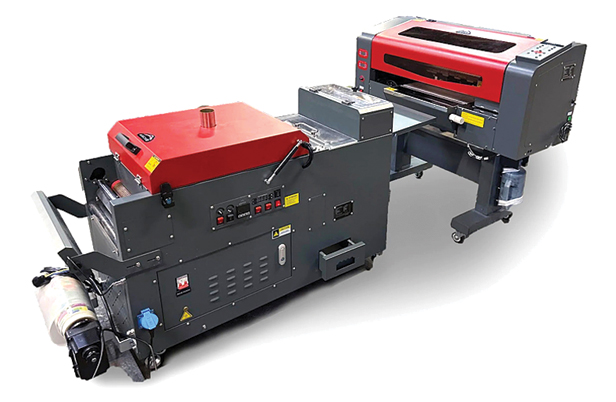Strategy March 07, 2024
Decorator’s View: 9 Reasons Direct-to-Film Printing Has Become So Popular
DTF printing offers vibrant, durable designs on a variety of textiles and hard substrates.
Print and embroidery shops are rapidly adopting direct-to-film (DTF) printing – and with good reason. DTF allows you to quickly print incredibly high-contrast, full-color designs on a special film.

Brian Belk, Axiom America
Unlike other decorating methods, you can transfer a DTF print with heat onto almost any kind of fabric or textile, from cotton/polyester blends and leather, to nylon or cordura. UV DTF technology allows for pressure-sensitive application on hard substrates such as plastics, wood, glass and metal.
Decorator’s View is a regular column written by screen printers, embroiderers and other apparel-decorating experts, sharing their best business-building, marketing and technical tips to help the promo industry elevate logoed apparel.
The DTF process involves specialty equipment that prints your artwork directly on a film, making this a transfer printing process. This imprinting technique lets distributors and decorators quickly create vibrant designs for a variety of purposes and substrates. Here are nine compelling reasons why so many promo pros are adding DTF to their lineups, whether they purchase the equipment or outsource the transfer creation to another vendor.
1. Turn out high-quality designs with a soft-hand feel.
DTF transfers allow you to print vibrant, long-lasting, full-color photorealistic designs with a limitless color palette of CMYK hues. With DTF, you can achieve color gradients, blends, patterns with defined edges, fine lines and details, and free-floating text, so you can give your clients exactly what they want in a logo or full-front T-shirt design. DTF designs have a soft-hand feel for a wearer’s comfort, unlike some vinyl designs or heavier screen prints with an underbase.
2. Print on almost any textile or substrate.
Direct-to-film prints require a much lower transfer temperature, allowing transfers to adhere to most textiles or hard substrates. This includes a diverse range of fabrics and textiles, such as cotton, polyester, cotton/poly blends, linen, crepe, jersey, silk, velvet, rayon, nylon, neoprene, leather, denim and synthetics previously unable to accept art transfers. UV DTF printing lets you weatherproof print high-contrast designs on nearly any nonporous surface, including glass, plastics, metal and more – perfect if your shop wants to decorate awards or other promo products in-house.

Arcus Printers offers the Pioneer 14 direct-to-film printer system for printing textiles.
The primary distinction between a DTF printer for textiles and a UV DTF printer lies in their respective printing processes. A DTF printer uses DTF film, DTF powder and DTF ink, requiring the additional steps of shaking powder and oven drying. Conversely, a UV DTF printer employs UV ink and AB film, and the process involves laminating. UV DTF printing uses a UV printer to directly print onto the film, eliminating the need for toner.
3. Create designs that last the test of time.
DTF ink penetrates deep within a fabric or textile once it’s transferred using a heat press, protecting against peeling, cracking and fading. For an even longer-lasting design on glass, metal or other nonporous surfaces, UV DTF ink is UV cured and protected by being encapsulated in a varnish-layered exterior.
4. Print on both light and dark garments.
DTF printing offers high-contrast results suitable for both light and dark garments. It uses a white base layer for vivid color printing, ensuring crystal-clear images with clean edges and no need for weeding. This method surpasses others in achieving vibrant, detailed prints, particularly on darker backgrounds.
5. Easily customize designs for clients.
Rather than needing costly setup or prepress work, you can quickly set up a custom design for a client – which is great for specialty work or smaller runs. You can also review the transfer for errors before applying it to a garment versus discovering a misprint after you’ve applied it to a completed shirt or destination surface.
Pro tip: Be aware that you might encounter size limitations depending on the size of your printer. If you’re planning to print very large designs, take that into consideration before you purchase a printer. You can also locate a vendor who can create transfers in larger sizes when you need them.
6. Apply your designs to any area of a garment or item.
Easily apply your transfer to any part of a garment, including challenging parts, since you’re using a heat press or curing oven. Plus, to increase a garment’s retail appeal and price point, add designs in multiple spots on a T-shirt, like the front, sleeve and back yoke.
What’s Involved With Setting Up DTF In House?
Many decorators starting with DTF outsource their transfer creation before committing to an in-house setup, which can be a considerable business investment depending on various factors. Here’s what you need to get set up to print DTF transfers:
- DTF printer: These machines range in price, size and capabilities, but you do get the quality you pay for, so talk to a reputable manufacturer to decide which is best for your shop’s production.
- DTK ink: To get started, you’ll need a large ink kit with all the colors you’ll need.
- DTF adhesive powder: During this process, you’ll apply this powder onto your film, and then transfer the design onto your surface with heat.
- DTF film: You can purchase the film in sheets or rolls in different sizes.
- Heating element to cure adhesive: You can use a heat press or curing oven. A manufacturer can offer you the best options for your setup.
7. Easily fulfill orders of all sizes and types quickly with DTF printing.
DTF prints can be cured directly onto the transfer film, allowing you to store press-ready artwork indefinitely. This capability enables larger print runs before needing any garments and facilitates the production of bulk components like athletic numbers or tagless care instructions.
You can also quickly produce full-color, custom runs of 35 pieces and under, a more efficient option than screen printing when you’re doing smaller, full-color jobs. If you’re a screen printer, having DTF transfers at the ready makes you more versatile, since you can produce DTF film positives fast.
Pro tip: Some decorators caution that for an order of thousands of T-shirts, traditional screen printing can be more economical and time effective.
8. Create a cost-effective decoration.
For day-to-day printing production, DTF is a cost-effective way to produce film positives without the time-consuming tasks of separating your artwork, making screens, pretreating your garment or weeding your design.
DTF film generally costs less than 70 cents per square foot to print. Film positives, which are essential for creating a sharp and detailed print, have a high resolution and sharp edges, which allows for clean and crisp printing.
9. Support client web stores with DTF printing.
If you want to expand your service offering with web stores you manage and fulfill, DTF lets you easily and quickly produce and ship on-demand garments. DTF also offers the flexibility of creating one-color logos or full-color designs with impressive texture and detail.
Brian Belk is managing director of Axiom America and its subsidiary Arcus Printers, a nationwide provider of decorating equipment, including direct-to-film (DTF) printers, UV DTF printers, DTF software and sublimation printers.
